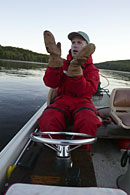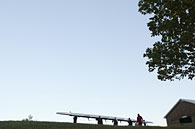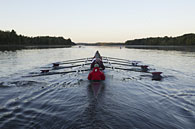Different Strokes
The Bates varsity rowing program strokes to the beat of a different drummer.
Story by Charles Strum, photos by Phyllis Graber Jensen
Rowing is the oldest intercollegiate sport in the United States and a religion among its disciples. Bates has 50 of them and, pardon the pun, mainstream athletes they are not.
Playing football or basketball is mainstream. So is being a Presbyterian. Rowing is monastic. It’s a team sport for individuals who train in isolation and carry their ambition into the spartan confines of a racing shell, where they sit with a view of a teammate’s back. Druids were less cloistered.
 Each weekday morning at 5:10, fall and spring, Bates rowers drive 15 minutes in darkness to the college boathouse on the Androscoggin River, lift their carbon-fiber shells above their heads, and march in ceremonial procession to the water’s edge. At first light they launch their impossibly narrow boats and – here we wring the metaphor dry – raise their oars in benediction to the trinity of strength, speed, and synchronization.
Each weekday morning at 5:10, fall and spring, Bates rowers drive 15 minutes in darkness to the college boathouse on the Androscoggin River, lift their carbon-fiber shells above their heads, and march in ceremonial procession to the water’s edge. At first light they launch their impossibly narrow boats and – here we wring the metaphor dry – raise their oars in benediction to the trinity of strength, speed, and synchronization.
They also curse the hour, resist the urge to barf, and endure oxygen deprivation that scorches muscles and lungs, all in pursuit of the ultimate satisfaction: the swiftest boat.
This happens rain or shine. At Bates, it can happen in snow, too.
That’s what made me wonder, in spring 2000, the second semester of my daughter’s first year, if rowing was something she should be doing. Initially, it was not clear if rowing was unhealthy, too demanding (stealing time from research at Ladd library, of course), or if it was, indeed, something far more dangerous: cult indoctrination.
Then her mother and I heard about the erg test – a kind of voluntary human sacrifice – which is scary in the abstract and worse in person. But more of that later.
When you watch the Bates crew, you’re watching a fledgling varsity program -1999 was its first year – with a short back story. The man in charge now is Andrew Carter, 34, a championship Canadian rower and coach who came to Bates in 2000 after stints at the University of Southern California and at Vassar, where he was head coach from 1996 to 1999. Under Carter, the program notched its first national championship, the women’s novice 8’s victory at the 2002 Avaya Championship Regatta.
Carter is blond and boyish looking, and the men’s varsity rowers are considerably taller and beefier than their coach. But where competitive rowing is concerned, he wields the ultimate power, with X-ray vision for technique, an innate sense of timing on the water, and a scientist’s absolute understanding of how to make a 60-foot boat go faster than a rival’s.
Carter was trained in applied sports science (kinesiology) and biomechanics. He can tell you why a slight dip in your shoulders will hinder the power in your legs (or maybe it’s the other way around). He also encourages his rowers to avoid tension. Even a contorted facial expression can hinder your stroke by sending bad vibes to the rest of your body. In Carter’s view, the body must be able to perform the full range of motion of the stroke. Try to “feel” the boat, he tells them. The race isn’t always won by the rowers who pull the hardest, but by those who can put the blade in and take it out with relaxed precision.
 At a typical morning practice, Carter sits behind the wheel of a Boston Whaler, cozy in a storm-resistant coverall that looks like a hazmat suit. Like a bee to flowers, he zips to each of the three or four boats on the water. The Whaler slows near one boat, and Carter watches for signs – invisible to a visitor – that the rowers are out of sync, or that a boat is swaying. On this late September morning, he watches the men’s varsity for a few minutes through a lifting fog bank, grins, and says, almost in sympathy, “They look half asleep today.”
At a typical morning practice, Carter sits behind the wheel of a Boston Whaler, cozy in a storm-resistant coverall that looks like a hazmat suit. Like a bee to flowers, he zips to each of the three or four boats on the water. The Whaler slows near one boat, and Carter watches for signs – invisible to a visitor – that the rowers are out of sync, or that a boat is swaying. On this late September morning, he watches the men’s varsity for a few minutes through a lifting fog bank, grins, and says, almost in sympathy, “They look half asleep today.”
The Bates Student first noticed a nascent interest in crew in 1985. Fueled by the enthusiasm of Arnold Robinson ’87 and a few other committed Batesies, rowing became a club sport without a boat. The first purchase was an ergometer for training, followed by two used four-seat shells donated by Grant ’57 and Joanne Trogler Reynolds ’58. Soon, President Reynolds agreed to purchase riverfront property in Greene and build a boathouse.
The boathouse, designed by the Bates Facility Services 15 years ago, is an unheated minibarn whose lights are powered by a gasoline generator. It is a monument to the bootstrap nature of the program. Carter prevailed on a Maine paper company to donate a huge swath of used industrial-strength felt – it resembles a beige billiard-table cover – to cushion boats from the gritty floor of packed sand. Two portable toilets stand guard out back, not far from where the pasture dips down precariously to the muddy banks of the Androscoggin.
Its flow blocked by mounds of rocks and sand left by melting glaciers 20,000 years ago, the Androscoggin forged a twisty, helter-skelter path through most of southwestern Maine. But here, well above the Great Falls in Lewiston-Auburn, the river widens and straightens, offering a gift to the sport of rowing: a serene 10-mile stretch of water that Carter calls “one of the best kept secrets in New England rowing.”
Geologists call the Androscoggin’s mostly twisty route a “deranged” path. That’s not a bad adjective, considering that rowers are a different sports species than their landlocked varsity counterparts.
“There’s this complete commitment, body and soul,” says Arnold Robinson, who is now a community planner in Newport, R.I. “The nature of crew and the nature of rowing is that it’s the sport of true believers.”
Robinson, and his wife, Molly, ’90, still row. He even admits having an ergometer in his basement, which is a bit like confiding that you’re nuts.
 As author Stephen Kiesling writes in his rowing book, The Shell Game: “The ergometer is a machine capable of measuring one’s physical capabilities as an oarsman.” In other words, an ergometer is the machine by which all rowers come to know how fast, how consistently fast, they can cover an imaginary course. It’s like Marine boot camp, but worse, since it’s self-inflicted.
As author Stephen Kiesling writes in his rowing book, The Shell Game: “The ergometer is a machine capable of measuring one’s physical capabilities as an oarsman.” In other words, an ergometer is the machine by which all rowers come to know how fast, how consistently fast, they can cover an imaginary course. It’s like Marine boot camp, but worse, since it’s self-inflicted.
“The term ‘rowing machine’ conjures up the junk advertised in mail-order athletic catalogs,” Kiesling continues. “An ergometer resembles that sort of rowing machine as an iron maiden resembles a corset….
“In its resting position the ergometer is inscrutable. It stands on a roughly triangular base of 4-by-4 inch steel girders, which supports the tracks of the sliding seat and an arm attached to a length of wooden oar. One rows on the machine as one rows a shell, but rather than having a uniform resistance against the sweep of the oar as in other rowing machines, the genius of the ergometer is that it harnesses the stroke to spin a massive steel flywheel. Momentum developed in the flywheel approximates the momentum of a shell.”
This rowing simulation tests power and consistency. If you watch an erg test in the fall, for example, you’ll see someone pulling an oar at breakneck speed for 20 minutes. The point is to go as far as you can (in meters) at a consistent speed. For men, that might mean running up a score of 6,000. A high number is desirable, of course, but only when coupled with consistent split times – the average time it takes the rower to go 500 meters. If your split times are a consistent 1 minute, 40 seconds per 500 meters (the machine displays this as you row), then you’re doing well.
At the end of the test, the rower can black out, throw up, just wish she were dead, or all three.
Melissa Young ’97, a former Bates coxswain, recalled an erg test taken by Mike Ferry, a classmate who would later compete in the 2000 Summer Olympics.
“It took four people standing on it to hold the erg machine in place,” she told the fall 2000 issue of Bates Magazine. “After the competition, Mike asked, ‘Is it bad if you taste blood?'”
But still they row, and with a clarity of purpose.
“The rowing stroke and the physics that goes along with the sport are intriguing. I love how ‘smart’ the sport is,” says coxswain Carly Rockstroh ’05 of Swampscott, Mass. “Rowing,” she adds, “is just simply addictive. Period.”
Mark Thomson ’03 of Minneapolis, a rowing co-captain, arrived at Bates as a skier and a runner, but was drawn to rowing “because it seemed like the classic collegiate sport – lots of tradition that I usually associated with prestigious East Coast schools.
“I often get comments from people, like how they couldn’t get up for practice,” he says. “They just don’t understand the feeling of racing and succeeding together. Sure I hate getting up at 4:50 a.m., but it’s worth it if we can bury another boat in the sprint because we worked harder.”
On a recent fall morning at 5 o’clock, the first to arrive outside Merrill Gymnasium is Emily Hoffer ’06 of Danville, Vt. I say hello, prepared for a wary response. After all, I am a middle-aged stranger with gray hair and a paunch. I am holding a Dunkin’ Donuts coffee cup, which I hope suggests I am friendly. Apparently, it works. I explain why I’m there and we strike up a conversation as rowers appear from out of the forest like members of Robin Hood’s merry (sleepy?) band. In a matter of minutes the crew assembles and heads to the parking lot.
If you have never driven to the boathouse, you probably won’t find it by yourself. This is my second trip, and all I can see in the annoying predawn fog as we turn onto Russell Street are short stretches of macadam. Mist obscures all landmarks, including the churchyard near an important left turn on to the road to the river. You can’t even see the strange homestead, just off the boathouse path, that everyone calls the deer farm. In daylight, it looks like an overcrowded petting zoo. Dozens of young deer, confined by chicken wire, pose in a landscape of boulders and scrub pine.
Six-foot-5 Ryan Champagne ’03 of Ballston Spa, N.Y., who rows fifth seat in the varsity 8, rides shotgun-navigator. In the fading glare of the parking lot floodlights, he directs me by dead reckoning along a route he can trace in his sleep, and probably often does.
When we arrive, the rowers remove some of their warmup gear (it’s 45 degrees and damp) and go for a 10-minute jog to get limber. I schmooze with Coach Carter, who seems bright-eyed and relaxed. He arrived ahead of us to turn on the generator for the lights, and we stand with some rowers at the boathouse entrance. In the shadows, wearing watch caps and fleece pullovers, they look as if they are about to launch a commando raid.
Daybreak is usually the quietest time on the water – little wind, few waves. By 5:50, dawn breaks and you can almost see colors. In a few minutes, the varsity and novice women will take their boats to the dock, a floating raft of scored black rubber that resembles a vastly enlarged sneaker tread. At Division I schools, like Yale, the crew does nothing with a boat but row it. At Bates and other NESCAC schools, rowers are also movers, mechanics and janitors. The rigging for each of the oars is detached for traveling, for example, and must be reattached and recalibrated before each regatta.
But now it’s time to get going.
Carly Rockstroh will cox the women’s varsity this morning. Looking fetching in oversized all-weather hooded jacket, gray sweatpants and bare feet in flip-flops, she calls the women to the boat rack, and the routine begins. For practice as for a regatta, the boats must get to the water, and the coxswain becomes the drill instructor.
The women walk to a rack where the boat is stored, upside down, and stand ready.
“Hands on, up an inch,” commands Rockstroh. “And up!” Hands on the boat, they lift it up an inch or so when she says, “Up.”
“Step it out,” says the coxswain, whose voice is light but whose terse, rhythmic commands cut through most ambient chatter. They walk the boat away from the rack.
Next: “To the shoulder, split.” Some rowers move to port, others to starboard. They lift the boat to their shoulders.
“Walk it out.” The rowers walk the boat out of the boathouse.
“Swing the stern.” They aim the boat toward the dock.
“Walk it forward.”
“Above heads, up!” They hoist the boat above their heads, arms extended, and continue walking.
At the dock, Rockstroh orders, “Step it to the side.” They step to the edge of the dock.
“Roll to waist, ready, roll!” They roll the boat to waist level. The boat is now right-side up.
“Put it out and in.” They push the boat away from their bodies and set it, gently, on the water.
For safety, Carter won’t let the boats leave the dock until he can see them, and he won’t return himself until they are docked securely. He and his assistant coach, Mark Welsh, who trains the novice boats, are the rescue crew if something goes wrong. On a morning that promises sun but remains misty on the river, he takes no chances.
“Someone dropped a cloud on us,” he says, as he casts off and picks up a bullhorn.
The novice men have the morning off. The novice women take off first, heading downstream into the mist, with Welsh trailing in an aluminum motorboat.
Carter and I go after the varsity boats in the Boston Whaler. He speeds up, the wind is brisk and the motor drowns out the sound of oars. Gradually, the shells come into view, like ghost lifeboats from some long-ago maritime catastrophe.
In the next hour or so, we will visit first one boat, then another. Carter watches, sometimes giving an order to the coxswains.
The only voices on the water are those of the coxswains. We putt-putt up to Rockstroh. The coach has a question about stroke frequency. When they chat across the water, it’s like breaking the stillness in church. We watch for a while and take off in the other direction.
At 6:48, after everyone has taken a short break, we catch up to the men’s varsity. They are having some balance problems this morning. The boat seems to roll side to side more than it should. Synchronization is off. Heads are up, heads are down. The coach analyzes, and then proposes a more complicated drill to the coxswain, Billy Tripp ’03 of Windham, Maine. The boat is stock-still; the rowers go through their motions as if in pantomime, oars just above the surface of the river.
At 7:12, the drills come to an end. Carter and Welsh shadow the shells into the dock. The portage process reverses itself. The mist is almost gone.
The pasture around the boathouse parking pad is dewy, and on the drive back to campus, the deer farm, the churchyard, and, finally, Russell Street, become visible. Bates, though, is still at rest. The athletic fields are empty.
Finally, it’s time for breakfast.